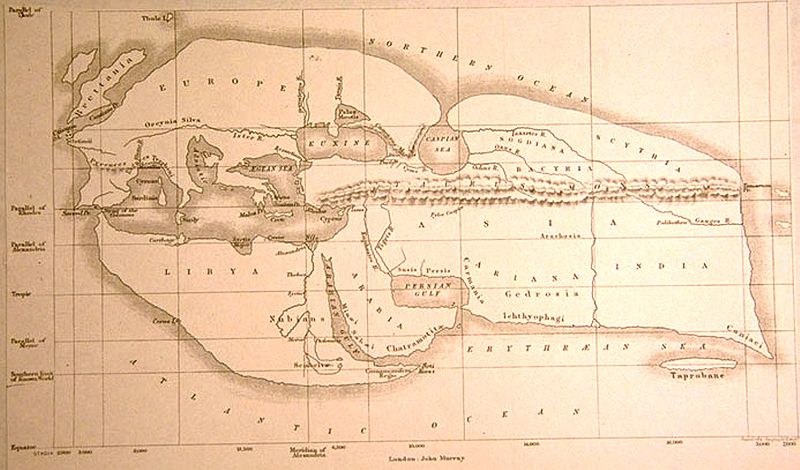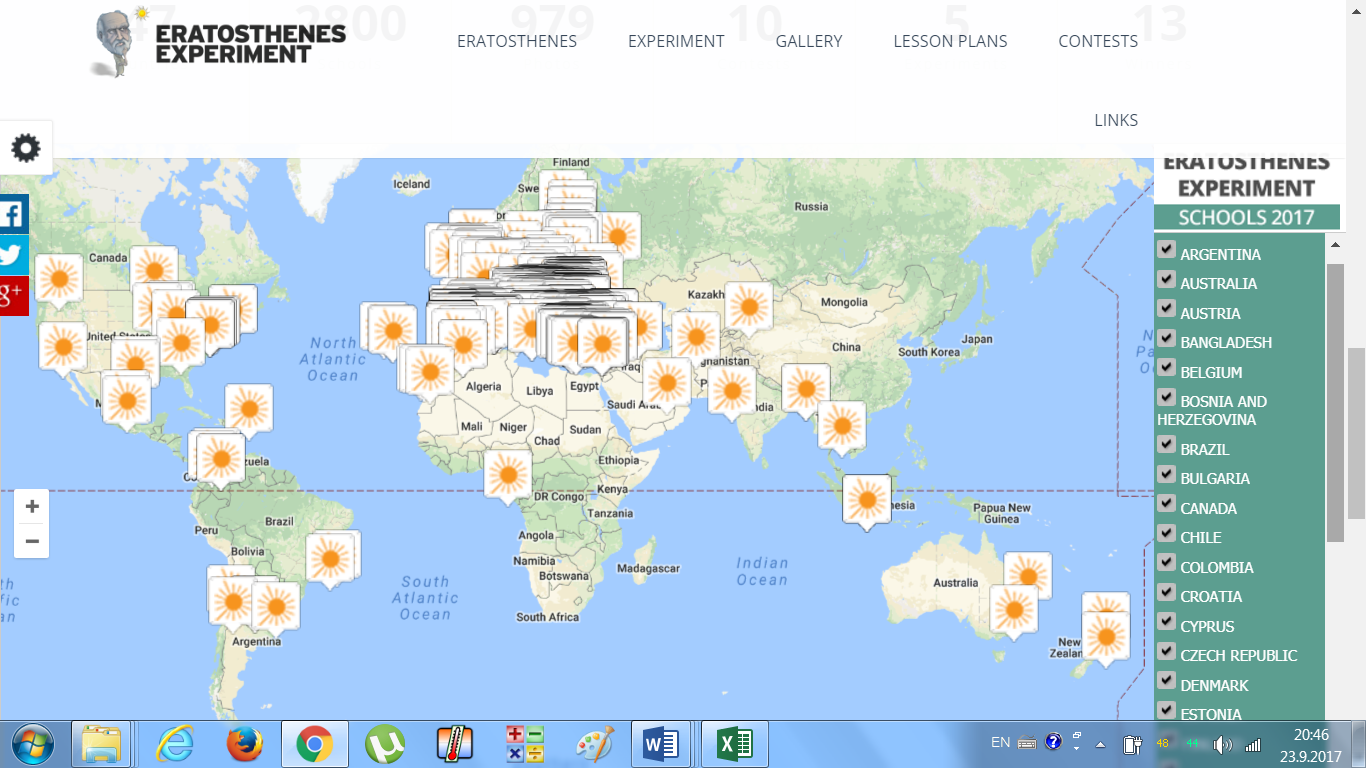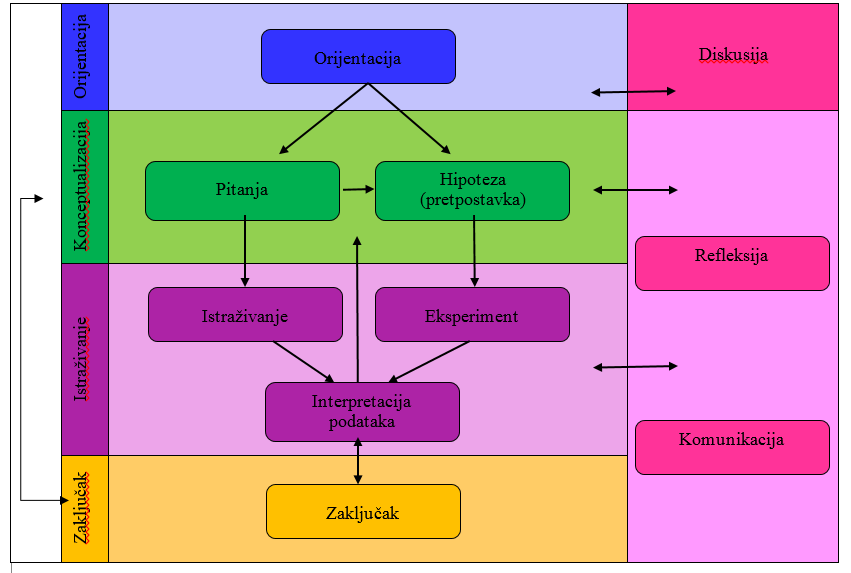Although Eratosatenov experiment known for more than 22 centuries, it is always a preferable example for our students and the implementation of Inquiry method.
Inquiry method is generally composed of five phases can be defined as follows:
Navigation, conceptualization, research, conclusion, and discussion.
In the first two phases, we can hypothesize that we will prove the performance of experiments. In this way, we can observe and Inquery method which is represented in mathematical logic through
Deduction-> Induction-> Abduction
Proceed from the assumption that the Earth is round (a fact that was known in ancient times, when Eratosthenes lived), experiments will be performed at the time of the autumnal equinox, by measuring the length of the shadow rod (preferably a length of 1 meter), and finding the ratio of the length of the shadow and the length of the rod . Finding a partner school which is located on the same meridian, and comparing the results, we find the approximate circumference of the Earth. The distance between the schools in a straight line is found using Google Earth or Google Map.
Concluding a sufficiently large number of experiments, the deductive method, we will determine the extent of the Earth. Statistical analysis of the data we will come to an inductive conclusion. As this is the first in a series of projects on the portal that we want to carry out, in relation to Eratosthenes experiment, we'll do it in a different point in time (the spring equinox in 2017) following a series of experiments. Comparing the results statistically by processing them, we find more accurate circumference of the Earth. As the Earth is not a perfect sphere more geoid (flattened at the poles due to the rotation around the Sun), we get more accurate results if the measuring point farther.
If possible, partner schools will use video conferencing as a means of direct communication for the duration of the experiment. At the end of the project, after adjustments to the results, predicting the final meeting of all stakeholders, where all schools to present the eTwinning portal live. Teachers will be common blog administrator of all participants, which will be the product of this project.
In this way, we will implement all phases of inquiry methodical approach to problem-solving.
Students have benefits through different ways of analyzing the issue of the project. The first is a research approach, teamwork, cooperation on the project, the development of various forms of reasoning, performing experiments, the application of acquired knowledge, multidisciplinarity (geography, astronomy, mathematics, history, physics, logic, philosophy, English language). Students with project partners not only exchange data with measurements but also information about their schools, which encourage multiculturalism.
Students become familiar with the applications of the knowledge acquired in everyday teaching and are complemented by the independent research work of students and in special classes in school.
How we plan to participate in the project, and elementary school students, who are not familiar with the principles of the use of the right triangle trigonometry, to determine the angles in it, we have prepared a table of values for the tangent angle, from which the students in lower grades of primary school with the ability to determine the appropriate angle , the angle of incidence of the sun in the solar noon, when performing experiments.
Schools that participate in this project, while also participating in a project organized by the Greek Eratosthenes experiment platforms at http://eratosthenes.ea.gr/en and http://www.eaae-astronomy.org/eratosthenes/. Our goal is that the participants of this platform include as associates in this eTwinning project.


The project provides seven basic stages:
1. Finding partners and their joining Eratostenovoj platform.
2. Determination students for project work (group or class).
3. Cooperation students (placing themed tasks to other collaborators on the project and historical aspect Eratosthenes experiment, collecting data related to the school and the city, etc.).
4. Measurements of the solar noon and exchange of measurement data and results with partners
5. The final match (video conferencing)
6. Establishment of the blog participants
7. Evaluation Project
--------------------------------------------------------------------------------------------------
Iako je Eratosatenov eksperiment poznat više od 22 veka, uvek je pogodan primer za naše učenike i primenu Inquiry metode.
Inquiry metoda su u opštem slučaju sastoji iz pet faza koje možemo definisati na sledeći način:
Orijentacija, konceptualizacija, istraživanje, zaključak i diskusija.

U prve dve faze možemo postaviti hipotezu koje ćemo dokazivati kroz izvodjenje eksperimanata. Na taj način možemo posmatrati i Inquery metodu koja je zastupljena u matematičkoj logici kroz sled
Dedukcija->Indukcija-> Abdukcija
Polazićemo od pretpostavke da je Zemlja okrugla (činjenica koja je bila poznata i u antičko vreme, kada je Eratosten i živeo), izvodićemo eksperimente u vreme jesenje ravnodnevice, mereći dužinu senke štapa (po mogućstvu dužine 1 metar) i nalazeći odnos dužine senke i dužine štapa. Nalazeći partnersku školu koja se nalazi na istom meridijanu, i uporedjujući rezultate, naćićemo približni obim Zemlje. Rastojanje izmedju škola u pravoj liniji nalazimo, koristeći Google Earth ili Google Map.
Zaključujući kroz dovoljno veliki broj eksperimenata, deduktivnom metodom, odredićemo obim Zemlje. Statističkom obradom podataka doći ćemo do induktivnog zaključka. Kako je ovo prvi u nizu projekata na portalu koje želimo da izvedemo, a vezano je za Eratostenov eksperiment, uradićemo u nekom drugom vremenskom trenutku (prolećna ravnodnevica 2017.) sledeći niz eksperimenata. Uporedjujući rezultate i statistički ih obradjujući, naći ćemo tačniji obim Zemlje. Kako Zemlja nije savršena lopta već geoid (spljoštena je na polovima zbog rotacije oko Sunca), tačnije rezultate dobijamo ukoliko su merne tačke udaljenije.
Ukoliko je moguće, partnerske škole će koristiti video konferenciju kao način direktne komunikacije, za vreme trajanja samog eksperimenta. Na kraju projekta, nakon sredjivanja rezultata, predvidjamo završni susret svih učesnika, gde će se sve škole predstaviti na portal eTwinning live. Nastavnici ce biti administrator zajedničkog bloga svih učesnika, koji će predstavljati produkt ovog projekta.
Na taj način ćemo primeniti sve faze u inquiry metodičkom pristupu rešavanja problema.
Učenici imaju benefite kroz razne načine obrade teme projekta. Prvi je istraživački pristup, timski rad, saradnja na projektu, razvijanje različitih oblika zaključivanja, izvodjenje eksperimenata, primena stečenih znanja, multidisciplinarnost (geografija, astronomija, matematika, istorija, fizika, logika, filozofija, engleski jezik). Učenici sa partnerima na projektu razmenjuju ne samo podatke sa merenja, već i informacije o svojoj školi, čime podstičemo multikulturalnost.
Učenici se upoznaju sa primenama znanja stečenih u svakodnevnoj nastavi, a dopunjena su kroz samostalne istraživačke radove učenika i na posebnim časovima u školi.
Kako planiramo da na projektu učestvuju i učenici osnovnih škola, koji nisu upoznati sa principima upotrebe trigonometrije u pravouglom trouglu, radi određivanja uglova u njemu, pripremili smo tablicu za vrednosti tangensa ugla, iz koje i učenici nižih razreda osnovne škole sa lakoćom mogu odrediti odgovarajući ugao, za upadni ugao Sunca u solarno podne, pri izvođenju eksperimenta.
Škole koje učestvuju u ovom projektu, istovremeno učestvuju i na projektu koji organizuje Grčka na Eratostenov eksperiment platformi na adresi http://eratosthenes.ea.gr/en i http://www.eaae-astronomy.org/eratosthenes/. Naš cilj je da i učesnike te platforme uključimo kao saradnike na ovom eTwinning projektu.


Projektom su predviđene sedam osnovnih faza:
- Nalažanje partnera i njihovo pridruživanje Eratostenovoj platformi.
- Određivanje učenika za rad na projektu (grupe ili odeljenja).
- Saradnja učenika (zadavanje tematskih zadataka drugim saradnicima na projektu-istorijski aspect Eratostenovog eksperimenta, sakupljanje podataka vezana za školu i mesto i slično).
- Merenja u solarno podne i razmena mernih podataka i rezultata sa partnerima
- Završni susret (video konferencija)
- Formiranje bloga učesnika
- Evaluacija projekta